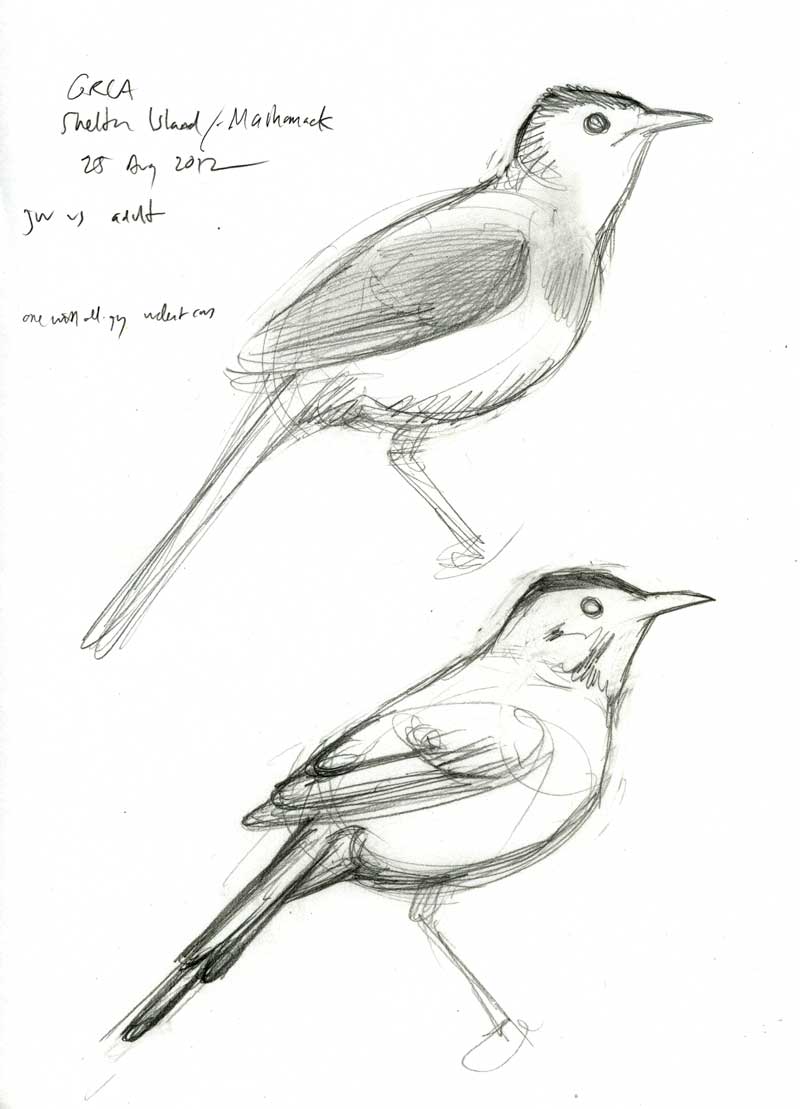Most Passerines only hold juvenal plumage for a few weeks, quickly molting to a more adult-like plumage soon after they fledge and before fall migration. It’s a plumage that is seen almost entirely on the breeding grounds, but the breeding grounds (and fledging time) of many birds overlaps broadly with the fall migration of others, so it’s common to see a mixture of juveniles and fall migrants of various species. Learning to recognize juvenile songbirds, and appreciating the things they all have in common, can help avoid confusion in the late summer and early fall.

As a general rule, the juvenal feathers of songbirds are lax, looking fluffy and creating a “hairy” texture, although this is more obvious in some families, less in others. The feathers are shorter and narrower than the same feathers on adults. This can affect the whole contour of the bird, as the juvenile often looks thinner, thin-necked, small-headed, etc.
In Gray Catbirds (as in the sketches shown here) the features that distinguish juveniles from adults include:
- very weak and fluffy undertail coverts (vs adults with stronger-looking, sleeker feathers there)
- fluffy and shaggy-looking feathers on belly
- fluffy texture on head (vs adults’ smoother and sleeker contours, except where interrupted by molt)
- smaller, more rounded head
- thinner neck
- no flight feather molt – all large wing and tail feathers are uniform in appearance and full-grown (vs. many adults actively molting wing and tail)
- pale gape (but this is lost early)
- less contrasting dark cap
- drab brownish eye (vs. rich reddish brown on adult)
- all wing feathers slightly paler and drabber gray-brown (vs darker with cleaner gray edges on adult)
Once young birds complete the late-summer molt to their first adult-like plumage (as early as July in some, but in other birds such as the ones I sketched not until mid-September) they are much more difficult to distinguish from adults. Eye color and the shapes of primaries and tail feathers (juvenile feathers which are retained for a full year) become the only reliable distinguishing features.


for about two weeks every summer I would say early July we stop seeing hummingbirds. Is there a reason for this?
Thank you for the informative article. I have been “raising” a young/immature catbird for about the last month or so. Backstory; I’ve been “friends” with its parents for the last 3 seasons. Nevertheless, I noticed around/near its head/eyes,…some “bare spots”. I presume this is associated or due in part to its molt, but I figured I’d ask an expert instead. I will try to take a photo if a reply is made. Thank you for the information.
Thank you David for the great explanation and drawings. I did not know young Catbirds could have a mid-September molt. It is September 18, 2020 In Valdosta, GA and as I was refilling a clear dome/bowl feeder in my backyard a round fluffy Gray Catbird flew in and landed on the hanging bowl as I was refilling It with seed. He being so unafraid and continuing to eat right next to me was puzzling, but now after knowing he is a juvenile it makes more sense why he wasn’t afraid (or just inexperienced). Thanks again